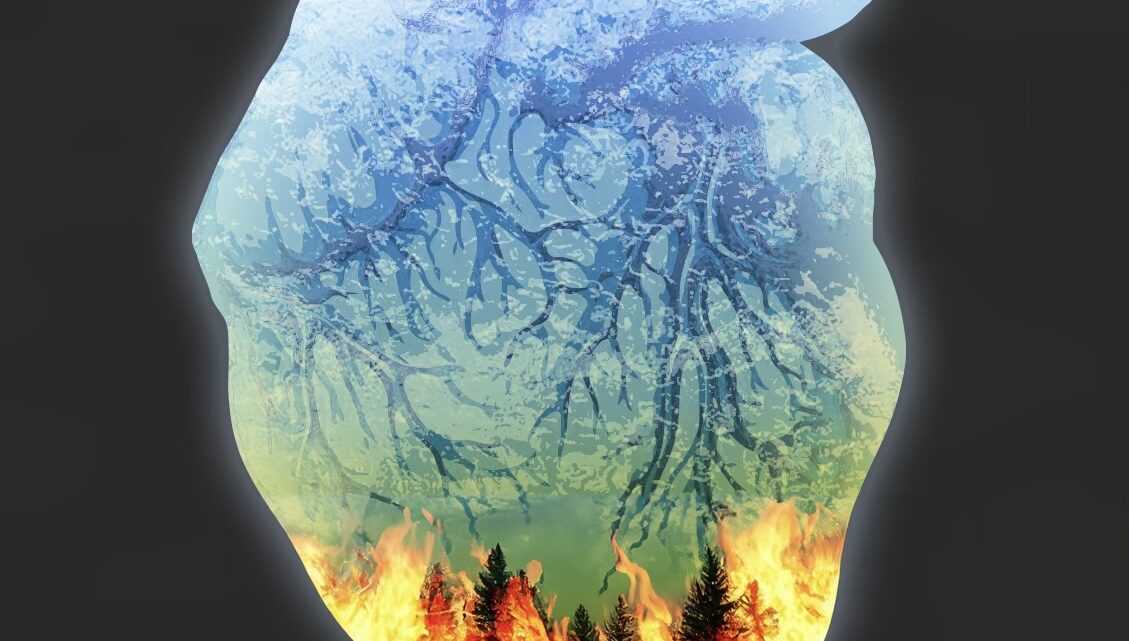How do We Warm the Hearts of Climate Sceptics?
Written by Roeland Dubèl
Artwork by Alec White
With the summer on its way, one weather record after another will fall again. The question is thus not if they will fall, but how many it will be this time. In the summer of 2022 for instance, 7,000 daily records were broken across the US, as well as 400 monthly records and 27 all-time records.[i] A marvellous performance, if it were to be the summer Olympics, but unfortunately so, we are discussing the structural rise in temperature on our beloved planet. And while it is a nice given that it is now easier to get a tan while relaxing on the beach, the consequences of climate change are imminent. Rising sea levels, consequent floods, droughts, forest fires, heat waves, insect outbreaks, decreasing biodiversity, decreasing food supply, more severe storms, melting of the ice caps, landslides, an increase in skin cancer patients and last but not least, inflation on the price of chocolate (droughts are namely increasingly plaguing cocoa production, the same by the way goes for coffee beans and wine grapes).[ii], [iii], [iv], [v], [vi], [vii] Then you begin to wonder whether it is worth the tan.
Although some still portray global warming as an external apocalypse, as something happening beyond us (read mankind), as being a natural fluctuation of time, that is a fairytale that belongs in a volume of the Brothers Grimm. After all, science has long known that climate change is happening, and that humans are directly connected to it. 97% of domain-related scientists are convinced that climate change is happening, a well-known figure.[viii] And quite coincidentally, climate change began to accelerate when humans started burning coal, at the time of the industrial revolution.[ix] Whereas ironically, climate sceptics and conspiracy advocates are all too happy to zoom in on coincidences, they however like to skip this one. Because sadly, not everyone believes in this scientific finding. Figures from the World Economic Forum (a Voldemort-like term for climate sceptics) show that roughly one third ofchange or does not even believe that the earth is warming at all.[x] Perhaps they should buy a thermostat. Again, we can hand out an Olympic (bronze) plaque to the US as being one of the countries housing the most climate sceptics[xi] (especially among those with a red sunburnt party colour,[xii] but more on this later).
With deniers on one side and climate advocates on the other, not only is the earth’s temperature heating up, but so is the debate. Globally, the number of climate demonstrations is increasing as the crow flies.[xiii] A lovely initiative, when individual citizens give up their time and effort to fight for the future. But let’s take a slightly more detached look at it. After all, what do these demonstrations really get us? We know from the literature on protests that they are almost always portrayed negatively in the media.[xiv] A phenomenon referred to as the protest paradigm. A thousand men can walk peacefully hand in hand in the name of nature, but all it takes is one troublemaker among them and it is the troublemaker who will dominate the headlines. After all, people are inherently attracted to negative information,[xv] this applies to everyone, to journalists but just as much to demonstrators (after all, you don’t go to the streets to denounce something good; no, you call attention to the negative development of the climate). Also, we know from the literature that demonstrations often have little political effect. Often only the immediate result is a symbolic Parliamentary question.[xvi] A politician who can briefly grab the shine that he/she also cares about the climate.
But surely the purpose of all these protests and similar outcries should be to get those who have distanced themselves from the scientific consensus, the climate sceptics, back into reality. To all get on the same page. Only then will there be support in society, a large enough electorate, who can appoint the politicians who do want to implement structural climate policies, as unfortunately many do not. Whereas thank God, we are increasingly able to conclude multilateral treaties to battle climate change, we seem however unable to come up with a coherent story to convince sceptics.
To start with the basics, which term should we actually use? Climate change, global warming, climate disruption, climate crisis, climate catastrophe, they are all terms describing the same phenomenon. Although the findings are not always consistent, what term to use does seem to matter, something which can be described as a labelling effect. For instance, the term ‘global warming’ more strongly fuels the sentiment that humans are the main cause of the climate shift, while the term ‘climate change’ mainly evokes connotations that it is a natural phenomenon.[xvii] It also appears that when the term ‘global warming’ is used, people experience more certainty that it really exists, have more worries about it, perceive a greater degree of personal threat, give it a higher priority, and people become more willing to do something against it, compared to when the term ‘climate change’ is used.[xviii]
Although scientists prefer the term climate change, as it does not frame the issue to purely the rise in temperature of earth’s surface, the term global warming seems to be better understood by, and touch, the layman. In part, the inability of the term climate change to literally and figuratively move the general public has long been recognised, and policymakers have been searching for a term that is scientifically accurate but that also emanates seriousness.[xix] A set of terms that recently are increasingly being used by scientists, politicians and other prominent figures are climate disruption, climate catastrophe and climate crisis.[xx]
If these terms do anything it is indeed pronouncing seriousness. As being cries of despair of scientists and politicians who feel unheard. But again, let us take a step back. From a purely persuasive point of view, is it really wise to talk about climate change in this way? After all, we know that alarming images of climate change have the opposite effect. The classic images of a polar bear all alone on a small piece of ice namely evoke feelings of powerlessness. And that leads not to more, but rather to less willingness to do something for the climate.[xxi] The credo, there is no point in doing something about the climate because we are already lost, is a precedent we have set ourselves by communicating so catastrophically about it. It is therefore questionable whether the shift towards more emotional terms on climate change is so desirable. For instance, compared to other labels, the term ‘climate disruption’ appears to evoke a lot of fear.[xxii] And although fear makes people think (because people then want to vocalise the source of the fear), it is not a mobilising emotion[xxiii], the term would thus lead to little climate readiness. It has also been shown that the term ‘climate disruption’ triggers little personal commitment.[xxiv] And of course, we should not be under the illusion that with the ideal label, and a consistent use of it, that only then we will manage to convince the climate sceptics. The point is that the details in our communication matter.
Beyond terminology and emotions, personal values also matter. We need to have a clear picture of who the climate sceptics are that we are trying to convince. As mentioned briefly earlier, and not to create a two-camp, these are mainly people from the conservative side.[xxv] Conservatives and progressives have different underlying value patterns,[xxvi] something mostly characterologically underpinned.[xxvii] To put it bluntly, progressives, among others, are particularly concerned with themes such as the environment, equality and social welfare, where conservatives are concerned with individual responsibility, safety and traditions. With this in mind, it is naive to expect that if you wrap climate messages in progressive values, as is commonly done now,[xxviii] climate sceptics, who thus mostly come from the conservative spectrum, can be convinced. For instance, research shows that emphasising free market solutions, a desire that stems from the prioritization for individual responsibility among conservatives, was precisely what increased climate acceptance among conservatives. A tactic like this is also known as value-framing.[xxix]
Moral of the story is that we are currently doing too little to tell a persuasively effective and inclusive story that leads to climate acceptance by all. There are opportunities to convince climate sceptics that are not being seized. Where we are able to construct and sign complex treaties with a multitude of other states, we remain unable to deliver a coherent message advocating for the environment. Meanwhile our mission is so straightforward: where we need to cool the climate, there we should attempt to warm the hearts of climate sceptics.
[i] Samenow, J. & Stevens, H. (2022, September 13). Where excessive heat shattered records this summer, in maps. Washington Post. https://www.washingtonpost.com/climate-environment/interactive/2022/temperature-records-summer/
[ii] NASA. (n.d.). The Effects of Climate Change. Climate Change: Vital Signs of the Planet. https://climate.nasa.gov/effects/
[iii] Parker, E. H. C. (2021). The influence of climate change on skin cancer incidence – A
review of the evidence. International Journal of Women’s Dermatology, 7(1), 17–27. https://doi.org/10.1016/j.ijwd.2020.07.003
[iv] United Nations. (n.d.). Key Findings | United Nations. https://www.un.org/en/climatechange/science/key-findings
[v] Effects of Climate Change | Threats | WWF. (n.d.). World Wildlife Fund. https://www.worldwildlife.org/threats/effects-of-climate-change
[vi] Consequences of climate change. (n.d.). Climate Action. https://climate.ec.europa.eu/climate-change/consequences-climate-change_en
[vii] Euronews. (2022, September 18). From coffee to codfish: The foods that will get more expensive with climate change. Euronews. https://www.euronews.com/green/2022/09/18/from-coffee-to-codfish-the-foods-that-will-get-more-expensive-with-climate-change
[viii] Earl, R. J. (2016, December 14). Fact Checking The Claim Of 97% Consensus On Anthropogenic Climate Change. Forbes. https://www.forbes.com/sites/uhenergy/2016/12/14/fact-checking-the-97-consensus-on-anthropogenic-climate-change
[ix] Causes of climate (n.d.). AdaptNSW. https://www.climatechange.environment.nsw.gov.au/causes-climate-change
[x] Whiting, K. (2022, August 15). 3 charts that show how attitudes to climate science vary around the world. World Economic Forum. https://www.weforum.org/agenda/2020/01/climate-science-global-warming-most-sceptics-country/
[xi] Milman, O., & Harvey, F. (2021, August 25). US is hotbed of climate change denial, major global survey finds. The Guardian. https://www.theguardian.com/environment/2019/may/07/us-hotbed-climate-change-denial-international-poll
[xii] Hook, L., & Burn-Murdoch, J. (2019, September 15). Survey underscores high levels of US scepticism on climate change. Financial Times. https://www.ft.com/content/e5374b6c-d628-11e9-8367-807ebd53ab77
[xiii] Global Protest Tracker. (n.d.). Carnegie Endowment for International Peace. https://carnegieendowment.org/publications/interactive/protest-tracker
[xiv] Lee, F. L. (2014). Triggering the Protest Paradigm: Examining Factors Affecting News
Coverage of Protests. International Journal of Communication, 8, 22. https://africaneditors.org/journal/IJC/abstract/621FE1CA907
[xv] Rozin, P., & Royzman, E. B. (2001). Negativity Bias, Negativity Dominance, and
Contagion. Personality and Social Psychology Review, 5(4), 296–320. https://doi.org/10.1207/s15327957pspr0504_2
[xvi] Van Aelst, P., & Vliegenthart, R. (2014). Studying the Tango. Journalism Studies, 15(4),
392–410. https://doi.org/10.1080/1461670x.2013.831228
[xvii] Whitmarsh, L. (2008). What’s in a name? Commonalities and differences in public
understanding of “climate change” and “global warming.” Public Understanding of Science, 18(4), 401–420. https://doi.org/10.1177/0963662506073088
[xviii] Leiserowitz, A., Maibach, E., Roser-Renouf, C., & Smith, N. (2011). Global warming’s
six Americas, May 2011. Yale University and George Mason University.
[xix] Holdren JP (2010) Climate-change science and policy: what do we know? What should we
- In: Kavli Prize Symposium, International Cooperation in Science, Oslo, Norway. http://www. whitehouse.gov/sites/default/files/microsites/ostp/jph-kavli-9–2010.pdf.
[xx] Ramp, catastrofe of crisis: hoe noemen media klimaatverandering? (2023, May 19). OneWorld. https://www.oneworld.nl/lezen/klimaat/ramp-catastrofe-of-crisis-hoe-noemen-media-klimaatverandering/
[xxi] Bilandzic, H., Kalch, A., & Soentgen, J. (2017). Effects of Goal Framing and Emotions on
Perceived Threat and Willingness to Sacrifice for Climate Change. Science Communication, 39(4), 466–491. https://doi.org/10.1177/1075547017718553
[xxii] Jaskulsky, L., & Besel, R. D. (2013). Words That (Don’t) Matter: An Exploratory Study
of Four Climate Change Names in Environmental Discourse. Applied Environmental Education & Communication, 12(1), 38–45. https://doi.org/10.1080/1533015x.2013.795836
[xxiii] Marcus, G. E., & Mackuen, M. B. (1993). Anxiety, Enthusiasm, and the Vote: The
Emotional Underpinnings of Learning and Involvement During Presidential Campaigns. American Political Science Review, 87(3), 672–685. https://doi.org/10.2307/2938743
[xxiv] O’neill, S., & Nicholson-Cole, S. (2009). “Fear won’t do it” promoting positive
engagement with climate change through visual and iconic representations. Science communication, 30(3), 355-379.
[xxv] Poortinga, W., Spence, A., Whitmarsh, L., Capstick, S., & Pidgeon, N. F. (2011).
Uncertain climate: An investigation into public scepticism about anthropogenic climate change. Global environmental change, 21(3), 1015-1024. https://doi.org/10.1016/j.gloenvcha.2011.03.001
[xxvi] Jost, J. T. (2017). Ideological Asymmetries and the Essence of Political Psychology.
Political Psychology, 38(2), 167–208. https://doi.org/10.1111/pops.12407
[xxvii] Kerlinger, F. N. (2022). Liberalism and conservatism: The nature and structure of social
attitudes. Routledge.
[xxviii] Luers, A. (2013). Rethinking US climate advocacy. Climatic Change, 120(1–2), 13–19.
https://doi.org/10.1007/s10584-013-0797-1
[xxix] Dixon, G., Hmielowski, J., & Ma, Y. (2017). Improving climate change acceptance
among US conservatives through value-based message targeting. Science Communication, 39(4), 520-534.
Roeland Dubèl (1999) is a second-year Research Master’s student in Communication Science. His interests within the science of communication are in how the digitalisation of our media environment has affected our news consumption patterns, as well as how mediated political content can affect us emotionally. In his eyes, the goal of any science should be to answer as many questions as broadly and profoundly as possible. It is the ground for his passion for interdisciplinary science. Within his study, he loves to apply digital methods from the computational sciences, but he also has an interest in using physiological measurements from psychology and the neurosciences (to measure emotional reactions in specific). It reflects his key idea that one is better able to answer questions when one looks at it interdisciplinary.


